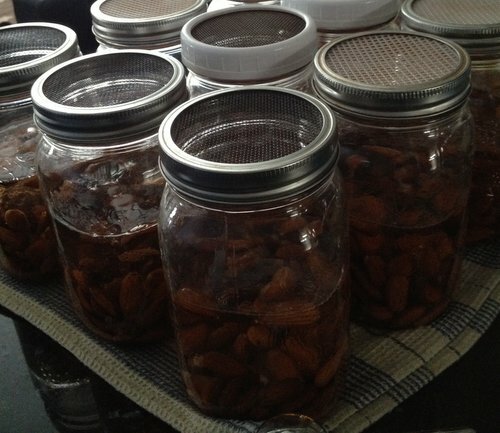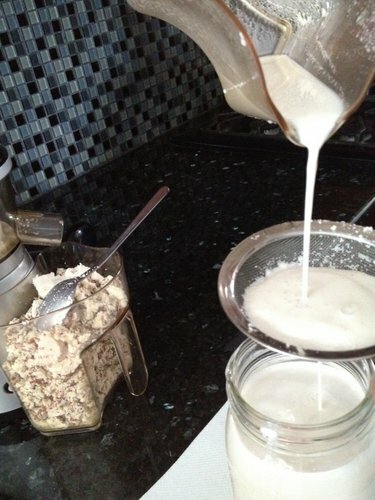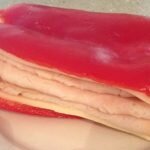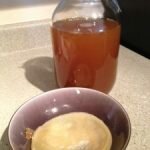Almonds are super nutritious and great for pregnant women who need the extra calcium. I don’t like to eat almonds, though, because nut fiber is irritating to my gut. Almond milk, on the other hand, (juiced, strained almonds) makes a great way to comfortably obtain all their nutrients. But getting your hands on real almond milk isn’t as easy as health food store shelves makes it seem.
Boxed almond milks are full of additives like synthetic vitamins and emulsifiers, so I make my own when I want it (there’s a recipe at the bottom) but since I am so busy I thought it would be pretty cool if I could find some intelligent almond milk supplier, someone who makes it raw and doesn’t include any additives. And wouldn’t you know, I found one!
But he’s in Canada.
So, while I can’t actually get any almond milk from him, I can get his take on what makes store bought almond milk so bad for you.
The following was contributed by Marc Jaoude from Markito Fitness in Montreal Canada.
That’s right friends – commercially sold almond milk, as found at your local health store, is damaging to your health as it stresses your immune system and contributes to chronic disease. Read on to find out why you should only drink homemade Almond Milk (shown below).
Synthetic Vitamins in Store-Bought “Almond Milk”
Here are just some of the harmful ingredients you will find listed on your store-bought “almond milk” carton:
Vitamin A Palmitate – This is a synthetic version of vitamin A that is associated with birth defects and bone fractures while providing zero health benefits. Other side effects of this isolated chemical form of vitamin A include tumor enhancement, joint disorders, osteoporosis, extreme dryness of eyes, mouth and skin, enlargement of liver and spleen, and immune suppression. As an added note, vitamin A toxicity, known as hyper-vitaminosis, always results from consuming too much synthetic “purified” vitamin A and never from naturally occurring vitamin A found from natural food sources. Still haven’t thrown out your store-bought “almond milk?”
Vitamin D2 – This synthetic chemical needs to be avoided at all costs as toxicity occurs easily with ingested synthetic D2. This occurs especially in children. In fact, a single dose of synthetic vitamin D of 50mg or greater is toxic for adults. The immediate effect of toxicity is abdominal cramps, nausea, and vomiting. In time, as toxicity builds, the result is a buildup of irreversible deposits of calcium crystals in the soft tissues of the body that damage the heart, lung and kidneys.*
Calcium Carbonate – This is a non organic, non-living mineral source of calcium and, most of the time, it is just plain chalk! That’s right- you are consuming chalk – the same stuff you use to write on a blackboard. Good luck with that!
Tocopherol Acetate – This is a synthetic man-made version of vitamin E. Studies have repeatedly shown that the human body prefers natural Vitamin E because it retains it at healthful levels while working to quickly excrete synthetic vitamin E.
Synthetic Vitamins Are Not Nutrients!
- Our digestive system does not recognize synthetic man-made vitamins as food.
- When you ingest a synthetic supplement, such as the ones found in “almond milk”, your body reacts as if you have swallowed some foreign toxic chemical. This means that your immune system must combat the enemy invasion. If you keep stressing your immune system in this way it will eventually become too weak to protect you from illness or disease.
- Lastly, since the very beginning of the boom in the supplement industry which included “fortified” and “enriched foods”, the scientific community has known, researched, and shown with every study that synthetic supplements weaken our health. In fact, these chemicals found in your “almond milk,” bread, and cereal boxes are not absorbed nor utilized by your body – instead they act as a burden to your health, even causing withdrawal symptoms when you eliminate them from your diet. Nothing replaces whole food, naturally occurring nutrients that your body naturally recognizes, absorbs, and utilizes as nourishment.
*For more information on all of the synthetic nutrients that you find in your everyday packaged foods I highly suggest that you pick up a copy of “Supplements Exposed” by Dr. Brian Clement. Also, you can read more warnings from the Organic Consumers Association regarding how isolated synthetic vitamins are not recognized or metabolized by the body in the same way as the naturally occurring versions.
Why Home-Made Almond Milk is Your Only Option
Other than toxic synthetic vitamins and minerals, your typical carton of store-bought “almond milk” also contains additives, preservatives, and added sugars. Even if you purchase what claims to be an unsweetened and organic product it will still contain the harmful chemicals that are a disaster for your body. Simply put, there is no healthy choice for almond milk that exists on supermarket shelves today.
Soaked, germinated almonds:
Markito Nutrition in Montreal Canada produces almond milk fresh, using organic, raw almonds that are soaked (germinated) overnight. The soaking disables the naturally present enzyme inhibitors of the nuts so that they can be easily digested by their own enzymes, rather than by pulling the enzymes from your body to digest them.
Unprocessed almonds:
Furthermore, the almonds we use are truly raw and organic almonds from Europe. Almonds that are cooked or processed not only lose many of their benefits, but can actually become harmful. Almonds labeled raw are not always truly “raw.” Commercially grown almonds in the U.S. (even though labelled as raw) are always sterilized by one of two methods: either using high temperatures (such as steaming) or fumigated with a chemical called propylene oxide. You don’t want almonds that have undergone either of these procedures. Heat treatments destroy many of the life-giving bioactive ingredients in almonds. Propylene oxide is a toxic carcinogen that has been banned for use on food products in Canada, Mexico, and the European Union. The only truly raw almonds available commercially are from Europe and these are the ones we use to make our almond milk.
Raw juicing:
First we run the almonds through a special masticating juicer that ensures the preservation of nutrients (as opposed to other systems that heat up and over oxidize the almonds) and then we manually strain the milk a final time before sealing your glass jar and giving it to you the very same day that it was produced.
Home-made Almond milk is good for you – synthetic versions will make you sick thus contributing to our “disease care” system.
To read more about the benefits of almonds you may visit our website: Markito Nutrition (Our almond milk is only available locally to our clients. If you live in Montreal, please contact us!)
Almond Milk Recipe
Yield: about 5 cups of almond milk
Ingredients
- 2 cups whole raw almonds
- 6 cups water
- 1 tsp vanilla extract (optional)
Other equipment:
- Blender or preferably a juicer
- cheesecloth or fine mesh strainer
Preparation:
Soak almonds overnight. This will soften them and break down the phytates. Drain the water from the almonds and discard.
Juice the almonds. Or you may blend on low speed with 3 of the 6 cups of water, pulsating or turning the blender off periodically to ensure the blender does not overheat.
Strain the mixture using a cheesecloth or fine mesh strainer into another container.
Homemade, raw almond milk will keep 3 or 4 days in the fridge. Freeze the extra.
The left-over almond particulate can be dried out in the oven on the lowest temp with the door cracked open. Use this in place of almond flour in “Paleo” cheat recipes if you are so inclined.



 Follow
Follow




16.05.2012 at 04:00
Peggy, you are AWESOME!
So many times I tried store almond milk only to waste money and to wind up chucking the container after reading the ingredients, plus it just tastes sugary and icky!
Thank you so much for this!
16.05.2012 at 06:49
Thanks Peggy,
I recently went dairy free due to food intolerance’s and increased my consumption of almonds only to find they exacerbate my gut issues. I thought I was going mad but you mentioned the fiber in nuts being irritating to your gut so now I know I am too. Thanks for the insight :0)Mel.
PS, I LOVE Brazil nut milk to, so delicious. I fermented some of my nut milks with kefir, very interesting :0) M
16.05.2012 at 07:58
Melanie,
Eating nuts, soaked, germinated, cultured, whatever, is so irritating to me. Not only does it bug my gut but my mood too! So many many people have similar issues with nuts. We’re definitely not alone.
16.05.2012 at 09:19
Melanie, I tried fermenting some brazil nut milk once and it came out really weird. I kept it around for a while and eventually just tossed it because it was too strange for me to drink (I’m pretty adventurous, but I just couldn’t wrap my brain / tastebuds around the flavour). Granted, I did it with just wild yeasts in my kitchem, maybe kefir grains would yield a more structured flavour?
Any tasting / fermenting advice?
16.05.2012 at 09:29
Sometimes when I’ve soaked the nuts, I throw in a splash of kombucha. The next day the nuts are a little sour, not super fermented but definitely sour. That’s where a pinch of sugar and vanilla comes in handy.
17.05.2012 at 06:53
I will try that. I have a bottle of kombucha that’s been sitting on my counter for a few months…. I love it, but I find it upsets my stomach straight up, so I’ve been using it for odd things, like instead of ACV.
Do you find that fermented stuff upsets your digestion? I had thought about doing a ferment-intesive diet earlier in the year to repopulate my gut, but even the little I ate seemed to cause bloating and upset. Annoying, because I love experimenting with it, and the idea seems good…
17.05.2012 at 07:13
Alexandra,
I used to think that fermented anything gave me stomach aches. But it seems I was mistaken. Lactose and fructose give me stomach aches. I can drink all the plain, ginger, and lemon kombucha I want with no gas, no bloating, and no stomach aches, on an empty stomach or with food.
I am still in amazement at how many foods I thought were causing me problems just because they were mixed with the sugars I couldn’t tolerate.
24.05.2012 at 01:13
Where do you get Brazil nuts that are fresh? So often, when we have some mixed nuts, I find one or two that taste almost rancid when bitten. There doesn’t seem to be any smell beforehand, but one of those would surely impart the taste to the milk.
I wish I didn’t live all the way across Canada from the almond milk supplier! I will have to try to find a local source of almonds in Alberta.
16.05.2012 at 09:20
I always had a feeling those boxed drinks werent so good for us despite them being a “health food”. I’ve made my own several times using this method and I even made macadamia nut milk and it came out very decadent.
16.05.2012 at 09:39
Wow, thank you for bringing us this information Peggy! After quitting dairy a couple weeks ago I’ve been drinking way too much commercial almond milk and figured it was an ok compromise. Oops, I guess I’ll go back to making my own. Although, since Montreal isn’t too far from Ottawa, maybe I’ll take a trip out that way and stock up on Marc’s product.
16.05.2012 at 09:58
Thanks for the great article Peggy! Missaralee, I’m from Ottawa as well, and I would love to get some almond milk if you plan on going to Montreal!
16.05.2012 at 10:02
Nathalie, I’ll definitely let you know when I venture out that way!
16.05.2012 at 10:05
Nathalie and Missaralee,
You’re welcome but, honestly, we should all be thanking Marc! He took the time to delve into the lies we’re fed about supplements and additives so that he could educate his clients and offer a high quality product.
I hope you guys do make it over there to see him. That would make my day!
16.05.2012 at 10:17
I am wanting to try this as I have bought the store bought almond milk assuming it would be healthy, until I actually read what was in it and they have added sugars and thickeners that cannot not be good for our bodies.
I was wondering if add the vanilla when you’re soaking the almonds or when you’re blending them?
17.05.2012 at 07:06
Jessi, oops! I forgot to mention that. Add the vanilla after you’ve strained it.
17.05.2012 at 03:22
Thanks! I wasn’t sure if I missed it or if it wasn’t there. I’m about to start the finish process on my soaked almonds. So excited for this!
I’m about to start the finish process on my soaked almonds. So excited for this!
16.05.2012 at 11:44
Hi Alexandra. I’ve not tried to ferment with wild yeast as yet so don’t know what it tastes like. I took the whey of kefir cultured ram milk and added it to the almond milk. Kefir creates a distinct fermented flavour all of it’s own. It is a little odd, I only left it overnight, that was enough. It’s worth a try, I’ll give the brazil nut milk a go with kefir soon. Any suggestions on other ways to ferment? What is wild yeast fermentation? Thanks Mel :0)
Thanks Peggy, I’m still persevering with some nuts, I find it’s too many almonds like in cake that do it….I was OK until a few months ago, I wonder what has changed?
17.05.2012 at 06:48
Wild yeast fermentation uses the bacteria / yeasts that are naturally occuring in our air. You just set things out and let nature take its course (although a little whey can help things along). This is how sourkraut, kimchi, and sourdough bread are made (and wine originally). Actually what you did is partially wild fermentation too, because although a starter will provide some of the bacterial population, others just come from the air. That’s why cities can each have ‘characteristic’ sourdoughs.
Anyway, I think mine might have just been particularly virulent for some reason, because it blew the cork out overnight. I also think that brazil nut milk wasn’t the best one to try fermenting first, because it was the contrast of the sourness and light carbonation with the creamy richness of it that really threw me. Maybe with almond milk it wouldn’t be quite as striking.
18.05.2012 at 12:03
Ahhh yes, like the lactobacilli on the cabbage leaves. I was reading about it in the Gut and Psychology syndrome book. I just made myself another batch of sauerkraut and it is so delicious. Maybe I could use the juice from this to ferment other vegetables….I love this fermenting stuff. After having many years of candida, fermented food has saved me.
I created a fermented carrot and ginger mix and it too went fizzy. A bit like ginger beer but not at all sweet ;0)
Someone mentioned getting tummy upset with fermented foods. in the Gut and Psychology syndrome book she discusses introducing it slowly like one tsp per day to see how your body manages. This may be worth trying as fermented foods offer so many positives.
16.05.2012 at 12:03
I’ve been making my own nut milks since my very brief and very partial flirtation with raw veganism a few yeas ago. Actually, I never even tried going vegan since that seemed like a dumb idea, but I incorporated some of their preparations where it seemed beneficial / tasty – nut milks, chia pudding, fermented stuff.
I use a high power blender and a chinois, which enables me to really get all the milk out. My favourite is actually brazil nut milk, which comes out exceptionally rich, almost like cream.
The store bought stuff, besides being full of crap, also doesn’t actually taste like almonds. It frankly just tastes like soy milk to me (ick). I’m not even sure how they achieve this.
Why is there so much crap food manufacturing? I often forget about it because I just buy raw ingredients, but then once in a while I start looking at stuff, and it’s like why? I mean, really, these folks can’t just taste some almonds and some water and make almond milk? It’s just so lame.
16.05.2012 at 08:06
Alexandra, how do you get the milk through the debris in the chinois? I’m curious because squeezing the milk out of cheesecloth is a bit of a hassle, which is what prompted me to go in search of almond milk to begin with.
Indeed it is odd how unlike almonds store-bought almond milk is. The homemade stuff actually tastes like almonds which is really neat. And double indeed, the fact that store-bought food products are really nothing like the food themselves is so damn frustrating. Why? (rhetorical)
16.05.2012 at 09:08
The chinois has a big wooden pestle that you sort of pound and press against the sides with. With very little force it just keeps squeezing more and more milk out. If you get one, just make sure it has a stand unless you think you have a deep enough pot it can hang over.
I got mine from Williams Sonoma but even though it was undoubtedly overpriced I have not regretted it, since it makes taking fibre out of anything a breeze. I’m sure you could find a cheaper version if you looked around, but don’t skimp on quality or it wont be as fine or wont withstand the pressure of the pestle.
16.05.2012 at 09:27
Wow, $100! For anyone wondering what we’re talking about, check out this link.
I don’t quite see where the pitcher or bowl would go if you used the stand though… But I can see how handy the pestle could be!
17.05.2012 at 06:36
I’m able to fit a 1 L capacity bowl under it. It’s about the amount of milk I make at a time anyway, so I don’t mind. I’ve avoided using it for soups because of the bowl size issue, but now that I’ve realised you can hang it over a pot… der.
If you’re going to look for a cheaper one, I’d recommned going and having a look at this one first just to see the fineness of mesh you want and how it feels under pressure.
It took me a long time to work up to buying this one, especially since WS has an evil exchange rate and I had to fork over $140 for it, despite our dollars being at about parity.
02.06.2012 at 08:34
I made coconut milk sorta like this before. And straining was the part that made me think it wasn’t worth doing. Maybe with something like this I would. But I’ve been finding out that raw milk is ok for me and it actually makes me happier, I think.
Thanks for all the almond info. I wanna cry because I soaked a bunch of commercial almonds I have in the freezer. Next time I’m getting good ones.
19.05.2012 at 10:16
Do you not worry about the high omega six content in almonds?
22.05.2012 at 08:07
Almonds are not one of the nuts with a very high omega six content, like peanuts for example. They have a lot of monounsaturated fats. And no, I am not worried about getting a few omega 6s from almonds because I do not eat or drink much of them. In fact, my diet is very low, in general, in omega 6s. I know a lot of people gorge on nuts and that can lead to some imbalances but I don’t do it and I don’t advocate it. One small pitcher of almond milk lasts my family a week and that’s about all the nuts we eat.
22.05.2012 at 05:32
When using a blender the instructions say to pulsate with 3 of the 6 cups of water… do I only use 3 cups of water if using a blender? I found this confusing… Thanks!
24.05.2012 at 07:25
Rebecca, sorry for the confusion. After you’ve sufficiently mixed the almonds and 3 cups of water and then removed the fiber, add the other 3 cups of water.
24.06.2012 at 12:39
If you are using a juicer, do you just mix the “juice” with the water? thanks!
25.06.2012 at 10:27
Yes. Almond “milk” is really just the juice from masticated almonds mixed with water.
26.06.2012 at 03:19
I used my juicer, and I got 0 liquid out of the almonds… Guess I’ll try the blender next!
27.06.2012 at 09:55
I tried my juicer too and had the same results! I don’t know what kind of juicer he has… but the blender works fine.
27.06.2012 at 02:49
You are right. The blender worked fine. My kids noticed the difference, I think because I didn’t add any sweetener, but they drank it again today! Success!
05.08.2012 at 07:52
You have to add the water through the jucicer, kinda like washing the ‘juice’ through.
10.08.2012 at 03:52
I just found your blog and immediately identified with everything you talk about (my story is a similar to yours and I am on a similar diet). It is good to know that I am not alone… I have just put some almonds to soak and will try the juicer method. I’ve done them the cheesecloth way before but it’s probably the reason I don’t do it more often!
13.09.2012 at 10:11
I was seraching the web for answers on why my homemade almond milk tastes “weird” on the next day and I found your blog and all this info about irradiation and pasteurization on american almonds. I’m really pissed off!!!! I spent time doing this because of my daugther’s health, only to found that I am giving her a nutrient killed food. No wonder the bad taste. Add to that, I lived in Colombia, South America where nuts costs a lot of money, so I was buying them in the States to bring it here… I am going to do some research to know the origin and handling procedure of almonds here in Colombia Thanks for illuminating my path
Thanks for illuminating my path 
14.09.2012 at 08:53
Hola Tanya! Mi novio es de Cali, Colombia! Cuando viajamos a Colombia traemos aceite de oliva y nueces. Son caro alli!
I am glad that you ran into this blog post. Store bought almond milk is really really bad. It pisses me off too because making it myself is so time consuming. Oh well. This is life in the modern world…
26.09.2012 at 03:19
So if added calcium is bad for you and you don’t consume dairy, how do you ensure you get enough calcium? According to what I’ve read, the natural calcium in almonds is not enough, even if you assume lower intakes are necessary for vegans. What’s your take on this issue?
26.09.2012 at 06:22
Hey Rachelle, I wrote a post on calcium a while back. https://theprimalparent.com/2012/02/15/calcium-dairy-free-pregnant-paleo/
Hopefully that helps.
27.09.2012 at 03:11
Hi Peggy! Quick question, how long does almond milk keep in the freezer? I’m not a huge milk drinker of any kind, but it would be nice to have some of the “good stuff” on hand to cook with, drink etc. etc. Thanks for the answer!
27.09.2012 at 10:08
I’m not exactly sure how long anything keeps in the freezer! Forever? No, I’m kidding. I really don’t know but I have read that breast milk keeps for 3 to 4 months if that helps at all.
05.10.2012 at 02:13
Hi to Everyone!
Try http://almondie.com/almond_milk.aspx
It’s the ultimate Almond milk!
19.05.2013 at 10:48
Has anyone tried this? I read somewhere that the healthiest almonds come from France as the ones produced in North America still have some chemicals used in the processing. I’m trying to find an alternative to importing from France. I’d love to mak my own almond milk. I didn’t realize commercially made almond milk bought in a health food store still has a lot of unhealthy ingredients
10.12.2012 at 09:08
How about Brazil nut milk? Homemade would have alot of calcium right?
03.01.2013 at 05:44
Thank you for this! I just started making my own! I’m sick of the bologna were served from food companies. My boyfriend bought me a ninja for Christmas and I’ve made some really great fresh foods. I love this blog!
07.02.2013 at 11:45
So if using a blender, do you add all 6 cups of water or just 3? I was confused on that. Do you blend with 3 cups and then add 3 more after it is strained?
17.02.2013 at 08:58
I stopped drinking cow’s milk quite some time ago and have substituted with commercial almond milk and other alternatives. I had always wondered what the calcium carbonate really was and just today did some research on it. I’m really happy that I found this article because it was EXACTLY what I was looking for. I would love to make my very own almond milk, I just haven’t looked into pricing just yet and where to get the truly raw almonds. I can’t afford a lot right now so I might have to find another, cheaper- yet truly healthy- alternative.. And to think I thought I was doing good things for my body. Fooled yet again!
20.02.2013 at 03:48
Hi Peggy, I was just wondering where you get your raw almonds to make the almond milk. Thank you
17.04.2013 at 11:19
Can I give this to my two year old as a milk alternative?
18.04.2013 at 10:56
Fresh almond milk would be a great drink for kids. Almond milk isn’t and “alternative to milk,” however. It does not contain a lot of calcium, saturated fats, or cholesterol – all of which are important for kids. Butter contains the last two and for calcium, check this post. https://theprimalparent.com/2012/02/15/calcium-dairy-free-pregnant-paleo/
16.05.2013 at 01:48
Do you have an idea of the nutritional content for homemade almond milk? I track all my calories on myfitness pal thanks for sharing this!
thanks for sharing this!
18.05.2013 at 09:00
I do not have a way to test for this myself and you can’t really plug in the numbers because so much of the fiber is discarded. It would be impossible to say how much of what you are losing in that.
15.06.2013 at 02:13
Very good article, but I do have one correction; Calcium carbonate is, in fact, organic and from a natural source. Calcium carbonate is by its chemical definition an organic molecule, as it contains carbon; please note that only living things are made up of organic (i.e. carbon-containing) compounds, and so all organic molecules are or were once present in living things. Calcium carbonate is no exception. The “chalk” you referenced is, indeed, chalk, but not the kind you’re thinking of; it’s a bit of a misnomer. The white chalky material from which dietary calcium carbonate is sourced is actually formed naturally through the slow accretion of the discarded shells and bones of sea life and calciferous plankton and amoebas. It’s the same stuff that makes the white cliffs of Dover famous.